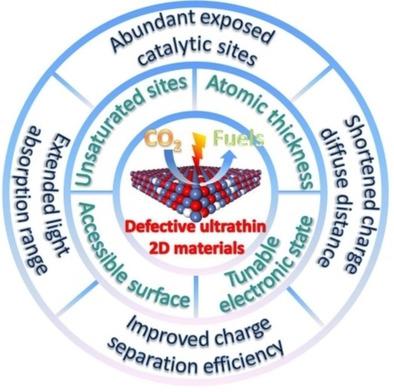当前位置:
X-MOL 学术
›
ChemNanoMat
›
论文详情
Our official English website, www.x-mol.net, welcomes your
feedback! (Note: you will need to create a separate account there.)
Vacancy Engineering of Ultrathin 2D Materials for Photocatalytic CO2 Reduction
ChemNanoMat ( IF 2.6 ) Pub Date : 2021-02-18 , DOI: 10.1002/cnma.202100051 YingXin Ma 1 , Bocheng Qiu 1 , Jinlong Zhang 2 , Mingyang Xing 3
ChemNanoMat ( IF 2.6 ) Pub Date : 2021-02-18 , DOI: 10.1002/cnma.202100051 YingXin Ma 1 , Bocheng Qiu 1 , Jinlong Zhang 2 , Mingyang Xing 3
Affiliation

|
Photocatalytic carbon dioxide (CO2) reduction is a sustainable and green strategy for the conversion of CO2 into hydrocarbon solar fuels, whereas its large‐scale application is severely restricted by lack of highly effective photocatalysts. Ultrathin 2D materials with tunable electronic structure display great potential towards photocatalytic CO2 reduction. However, the photocatalytic performance still remains unsatisfied due to high activation energy of CO2 molecules on catalytic sites. To this end, surface vacancy engineering can endow coordinately unsaturated sites as actively catalytic sites for CO2 molecules chemisorption and activation. In this review, we focus on vacancy‐engineered ultrathin materials for CO2 photoreduction. Different vacancies with classified anion vacancies, cation vacancies, vacancy pairs, voids, and their corresponding role in CO2 photoreduction are proposed. The different strategies based on vacancy engineering, including direct modulation of vacancy concentrations, refining vacancy states by heteroatom, and vacancy‐engineered heterostructure, are presented. Finally, the future developments and their associated challenges concerning defective ultrathin 2D materials are discussed.
中文翻译:

超薄二维材料用于光催化CO2还原的空缺工程
光催化还原二氧化碳(CO 2)是将CO 2转化为烃类太阳能燃料的一种可持续的绿色策略,而由于缺乏高效的光催化剂,其大规模应用受到了严重限制。具有可调电子结构的超薄2D材料在光催化CO 2还原方面显示出巨大潜力。然而,由于CO 2分子在催化位点上的高活化能,其光催化性能仍然不能令人满意。为此,表面空位工程可以赋予不饱和位点作为CO 2的积极催化位点分子化学吸附和活化。在这篇综述中,我们重点研究了由空位设计的超薄材料用于CO 2的光还原。提出了具有分类的阴离子空位,阳离子空位,空位对,空位及其在CO 2光还原中的相应作用的不同空位。提出了基于空位工程的不同策略,包括直接调节空位浓度,通过杂原子细化空位状态以及空位工程化的异质结构。最后,讨论了有关缺陷超薄2D材料的未来发展及其相关的挑战。
更新日期:2021-04-08
中文翻译:

超薄二维材料用于光催化CO2还原的空缺工程
光催化还原二氧化碳(CO 2)是将CO 2转化为烃类太阳能燃料的一种可持续的绿色策略,而由于缺乏高效的光催化剂,其大规模应用受到了严重限制。具有可调电子结构的超薄2D材料在光催化CO 2还原方面显示出巨大潜力。然而,由于CO 2分子在催化位点上的高活化能,其光催化性能仍然不能令人满意。为此,表面空位工程可以赋予不饱和位点作为CO 2的积极催化位点分子化学吸附和活化。在这篇综述中,我们重点研究了由空位设计的超薄材料用于CO 2的光还原。提出了具有分类的阴离子空位,阳离子空位,空位对,空位及其在CO 2光还原中的相应作用的不同空位。提出了基于空位工程的不同策略,包括直接调节空位浓度,通过杂原子细化空位状态以及空位工程化的异质结构。最后,讨论了有关缺陷超薄2D材料的未来发展及其相关的挑战。











































 京公网安备 11010802027423号
京公网安备 11010802027423号